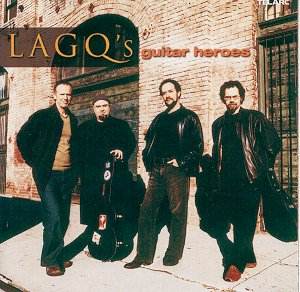 CD Reviews
CD Reviews MusicWeb
Webmaster: Len Mullenger
Len@musicweb.uk.net
[Jazz index][Purchase CDs][ Film MusicWeb][Classical MusicWeb][Gerard Hoffnung][MusicWeb Site Map]

LAGQ’s Guitar Heroes
Ralph TOWNER
(b.1940) Icarus (Ralph Towner/arr. Kanengiser)
Norman BLAKE
(b.1938) and David BROMBERG
(b.1945) B&B (Andrew York)
John MCLAUGHLIN
We Know You Know: Reverie for Mahavishnu
(Brian Head)
Jimi HENDRIX
(1942-1970) Pluck, Strum, and Hammer (Bryan
Johanson)
Pat METHENY
(b.1954) Letter from Home (Pat Metheny/arr.
Mark Small)
ASSAD DUO (Sérgio
b.1952, Odair b.1956)
Uarekena (Sergio Assad)
Steve HOWE (b.1947)
Aire para un Dia (Steve Howe/arr. Kanengiser)
Django REINHARDT (1910-1953)
Gypsy Flower (Matthew Dunne)
Duane YORK Pop
(Andy York)
LOS ROMEROS
El Baile de Luis Alonso (Jeronimo Gimenez/arr.
Pepe Romero)
Michael HEDGES
(1953-1977) Lament and Wake (Evan Hirschelman)
Frank ZAPPA
Let's Be Frank (Bryan Johanson)
Chet ATKINS
Blue Echo/Country Gentleman (Chet Atkins,
Boudleaux Bryant/arr. Kanengiser)
The Los Angeles Guitar Quartet: John Dearman,
Bill Kanengiser, Scott Tennant, Andrew York
(guitars)
rec. 8-11 December 2003, Studio A, O’Henry Sound
Studios, Los Angeles, California USA. DDD
![]() TELARC CD-80598 [61'17]
TELARC CD-80598 [61'17]
One popular view of Los Angeles is of a city of air-headed movie stars and wannabees, or alternatively of warring gangs. Artistic achievement? Perhaps a few arthouse movies ... oh, and the LA Philharmonic isn’t bad and there is Johnny Depp’s jazz club.
Well, it is time the notion of LA as lacking in serious artistic pretensions was knocked on the head. Just taking theatre, the city has more acting spaces than anywhere else in the US. And here is more evidence; the Los Angeles Guitar Quartet has produced an outstanding CD which manages to be both musically substantial yet incredibly easy to listen to at the same time.
The disc is a highly sophisticated set of tributes to the LAGQ’s mentors, influencers and teachers. With one exception (Los Romeros), the source material has been reworked in the style of the original model but always with a very individual LAGQ touch. From the outset, enterprise and invention are predominant; some interesting effects kick off Ralph Towner’s Icarus, segueing into an infectious samba. And variety is also the name of the game. The moto perpetuo bluegrass of B&B is followed by the warmly repetitive sixth-based chords of Reverie for Mahavishnu, while the proximity of Hendrix and Handel’s London residences (see http://www.handelhouse.org/), gives rise to some maniacal baroque whimsicality.
And so it goes on. Exuding intelligence and musicality, the arrangements provide for technical virtuosity and wonderful ensemble, four very individual musicians yet sounding as one. They seem to have absorbed all the styles, none sounds forced or applied. Metheny’s gentle, sunlit style seems as natural to them as the vigorous flamenco of Steve Howe or Django’s Latin impressionism, the Hot Club taking on some intriguingly chromatic harmonies. Michael Hedges’ very substantial sequences the simple but effective ostinato-based ‘Lament’ and a vigorous ‘Wake’, replete with extended techniques. The Zappa piece is five witty movements (irony on an ironist?) ending with a demented jig wandering about in a chromatic wilderness.
The CD concludes with a Chet Atkins-inspired comically twee country tune daftly reminiscent of the ‘Third Man’ theme. I laughed out loud and promptly played the whole CD again. The LAGQ represents the best in ‘crossover’ or ‘fusion’ music (there is no satisfactory term). They are classical players unafraid to incorporate any and all styles in classical forms; their ideas, whether from pop, world music or jazz are fully assimilated and, on this CD, turned into miniature masterpieces using their contrapuntal and melodic imaginations, not to mention formidable virtuosity. On top of that, the recording is exemplary.
This is my all-time favourite guitar record and I recommend it with huge enthusiasm.
Roger Blackburn